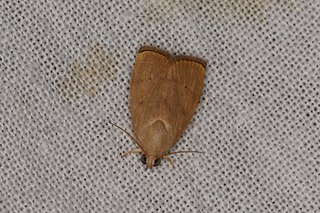
Mesapamea secalis, the common rustic, is a moth of the family Noctuidae. The species was first described by Carl Linnaeus in his 1758 10th edition of Systema Naturae. It is found in Europe, north-west Africa, Turkey and northern Iran.

Imma costipuncta is a moth of the family Immidae. It is known from Ambon Island of Indonesia.
Antaeotricha corvigera is a moth of the family Depressariidae first described by Edward Meyrick in 1915. It is found in Guyana and Peru.
Antaeotricha tribomias is a species of moth of the family Depressariidae. It is found in Guyana.
Stenoma bicensa is a moth of the family Depressariidae. It is found in Brazil and Panama.
Stenoma infusa is a moth of the family Depressariidae. It is found in French Guiana.
Chlamydastis bifida is a moth of the family Depressariidae. It is found in Brazil and the Guianas.
Barantola panarista is a moth in the family Depressariidae. It was described by Alfred Jefferis Turner in 1917. It is found in Australia, where it has been recorded from Queensland and New South Wales.
Antaeotricha camarina is a moth in the family Depressariidae. It was described by Edward Meyrick in 1915. It is found in Guyana.
Imma dioptrias is a moth in the family Immidae. It was described by Edward Meyrick in 1906. It is found on New Guinea.
Imma hyphantis is a moth in the family Immidae. It was described by Edward Meyrick in 1906. It is found in Sri Lanka.
Imma neurota is a moth in the family Immidae. It was described by Edward Meyrick in 1906. It is found on Borneo.
Imma thyriditis is a moth in the family Immidae. It was described by Edward Meyrick in 1906. It is found on the Solomon Islands.
Imma ancistrota is a moth in the family Immidae. It was described by Edward Meyrick in 1912. It is found on New Guinea.

Imma tetrascia is a moth in the family Immidae. It was described by Edward Meyrick in 1912. It is found in Australia, where it has been recorded from Queensland and Western Australia.
Imma grammarcha is a moth in the family Immidae. It was described by Edward Meyrick in 1905. It is found in Sri Lanka and possibly on Borneo.
Imma halonitis is a moth in the family Immidae. It was described by Edward Meyrick in 1920. It is found in Chennai, India.
Imma eriospila is a species of moth in the family Immidae. It was described by Edward Meyrick in 1922. It is found in Pará, Brazil.
Imma thianthes is a moth in the family Immidae. It was described by Edward Meyrick in 1927. It is found on New Ireland and New Hanover.

Ichneutica panda is a species of moth in the family Noctuidae. It is endemic to New Zealand and only found in central and southern parts of the South Island. The species has not been collected in Canterbury since the late 1950s and has not been seen at The Wilderness scientific reserve since 1941. This species is similar in appearance to Ichneutica falsidica however I. panda lack or have indistinct black dashes on their edge of their hindwings. I. panda inhabit shrubland from alpine zones down to river terraces and adults are on the wing between December and February. The life history of this species is unknown as is the host species of the larvae.



